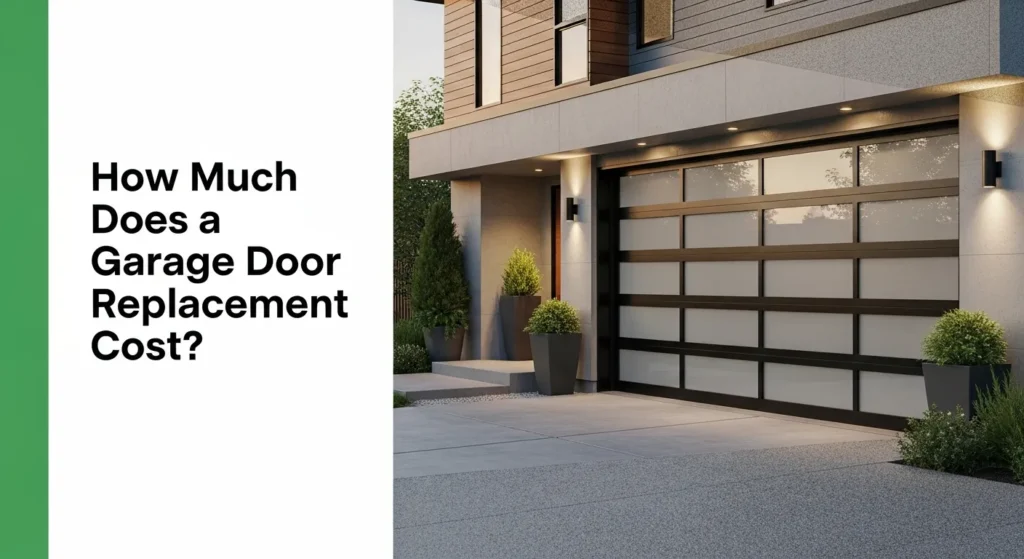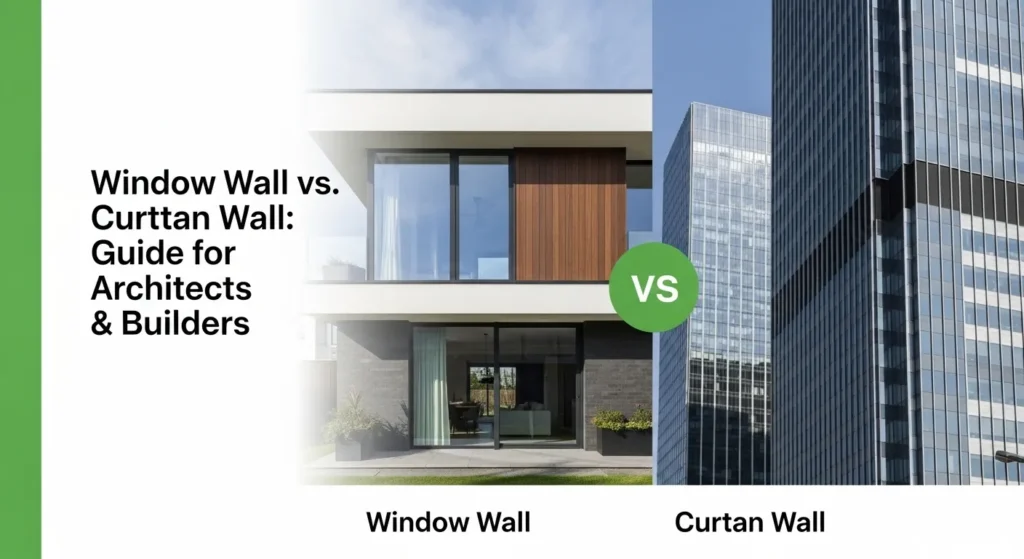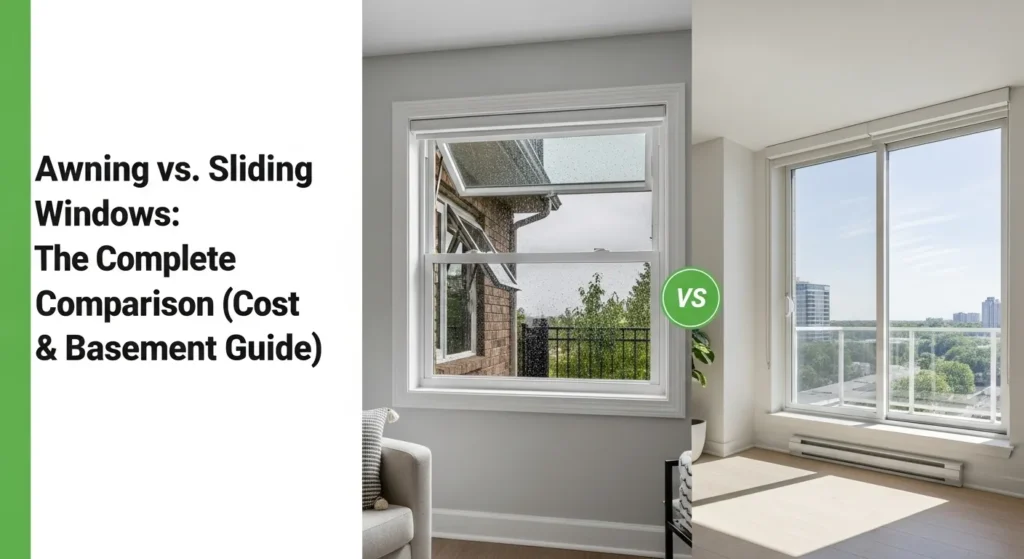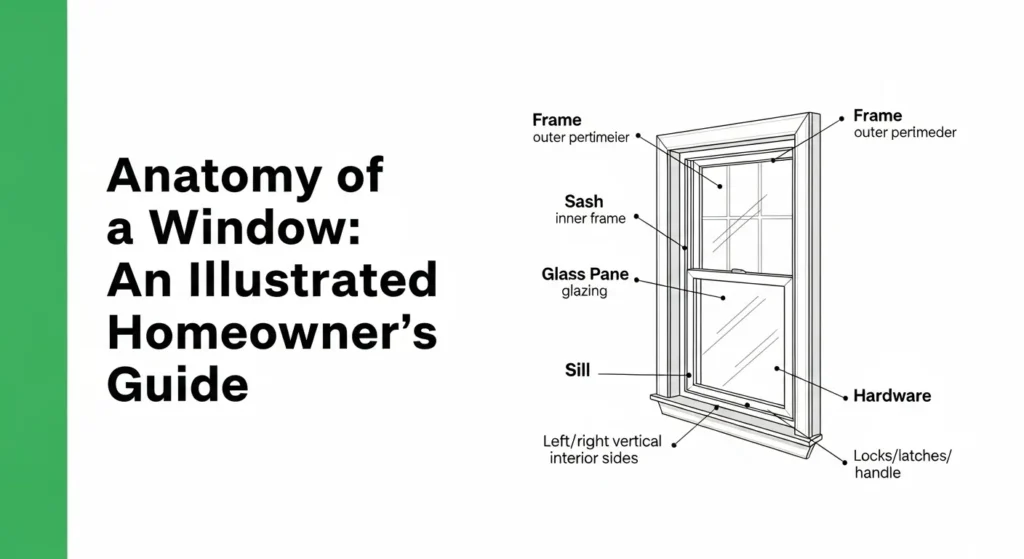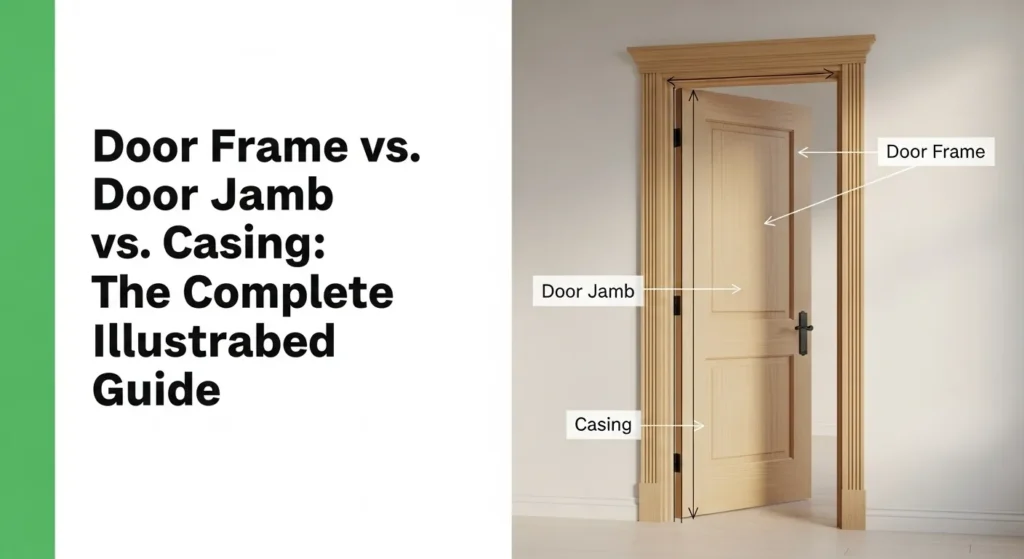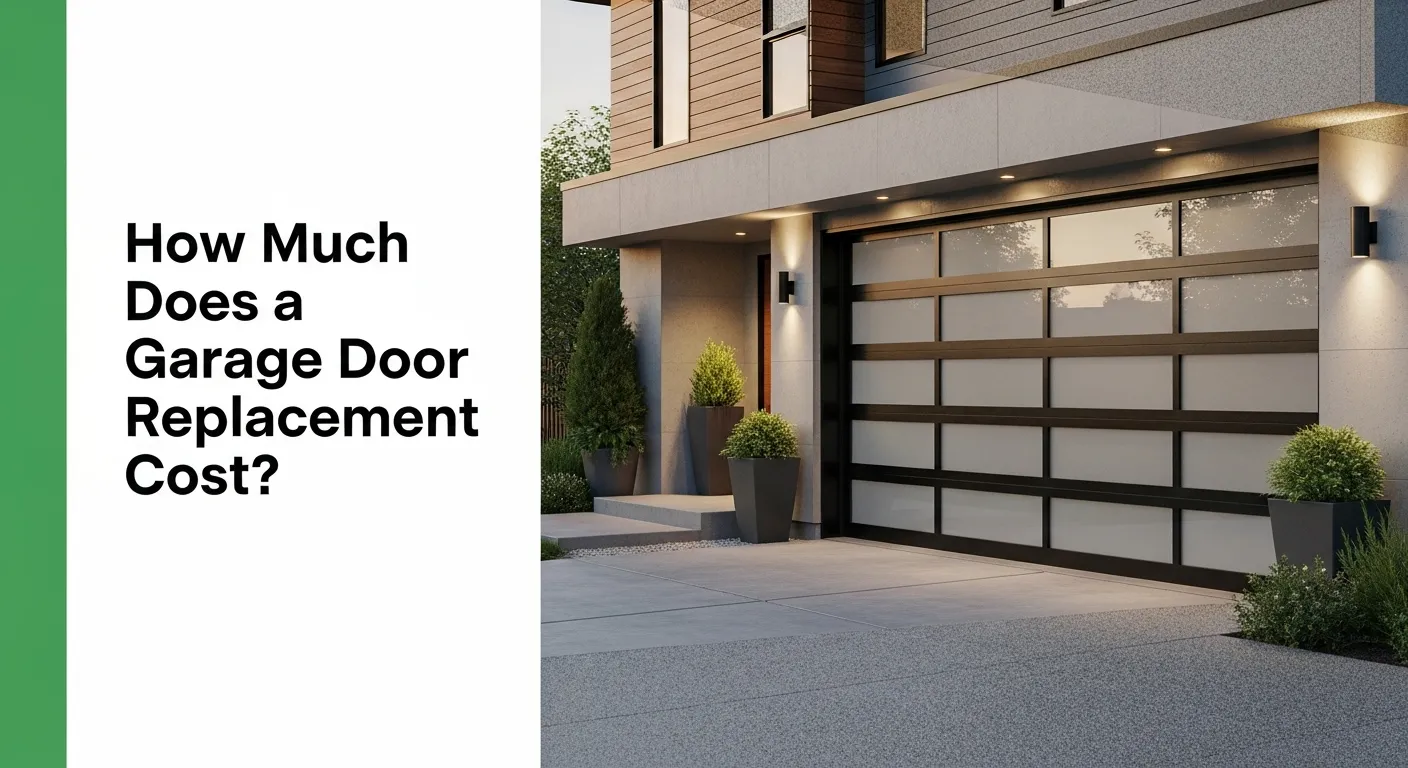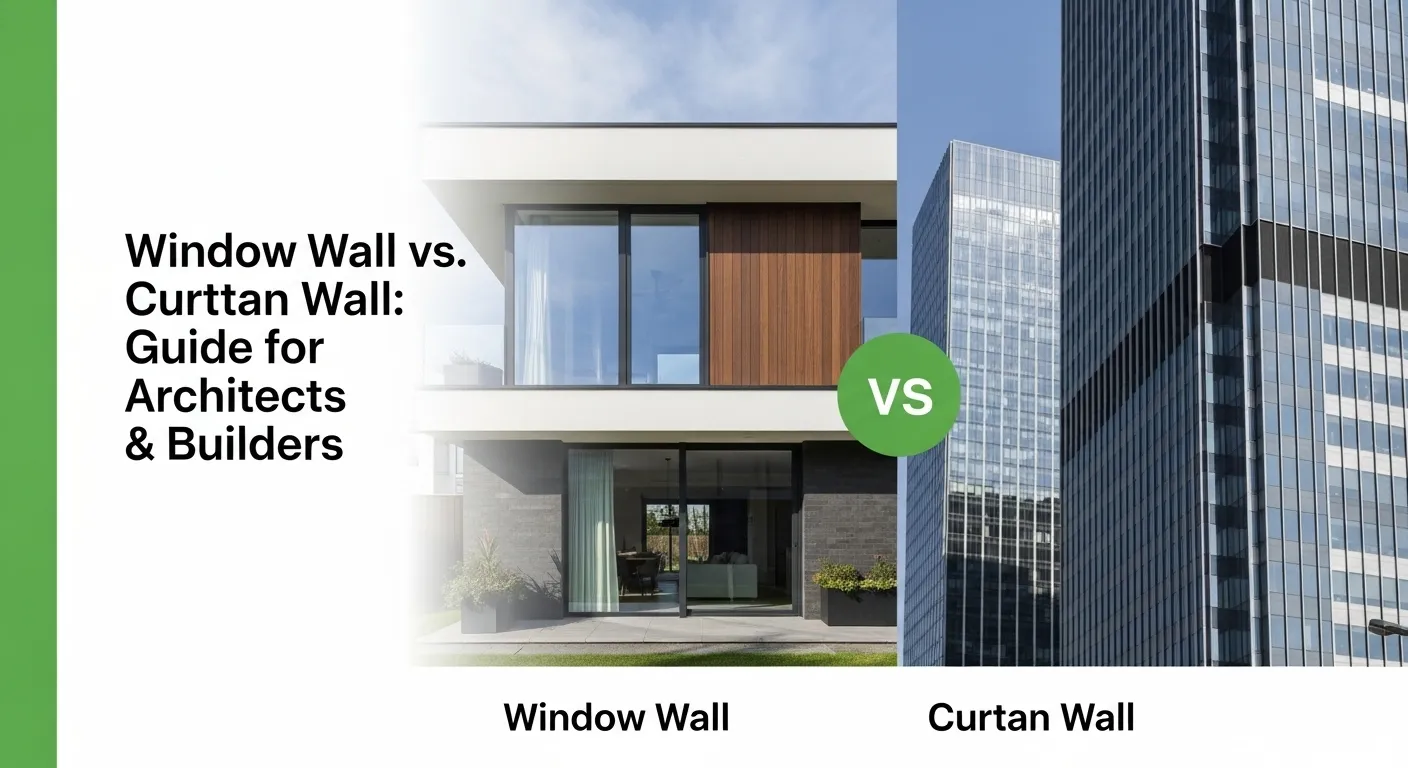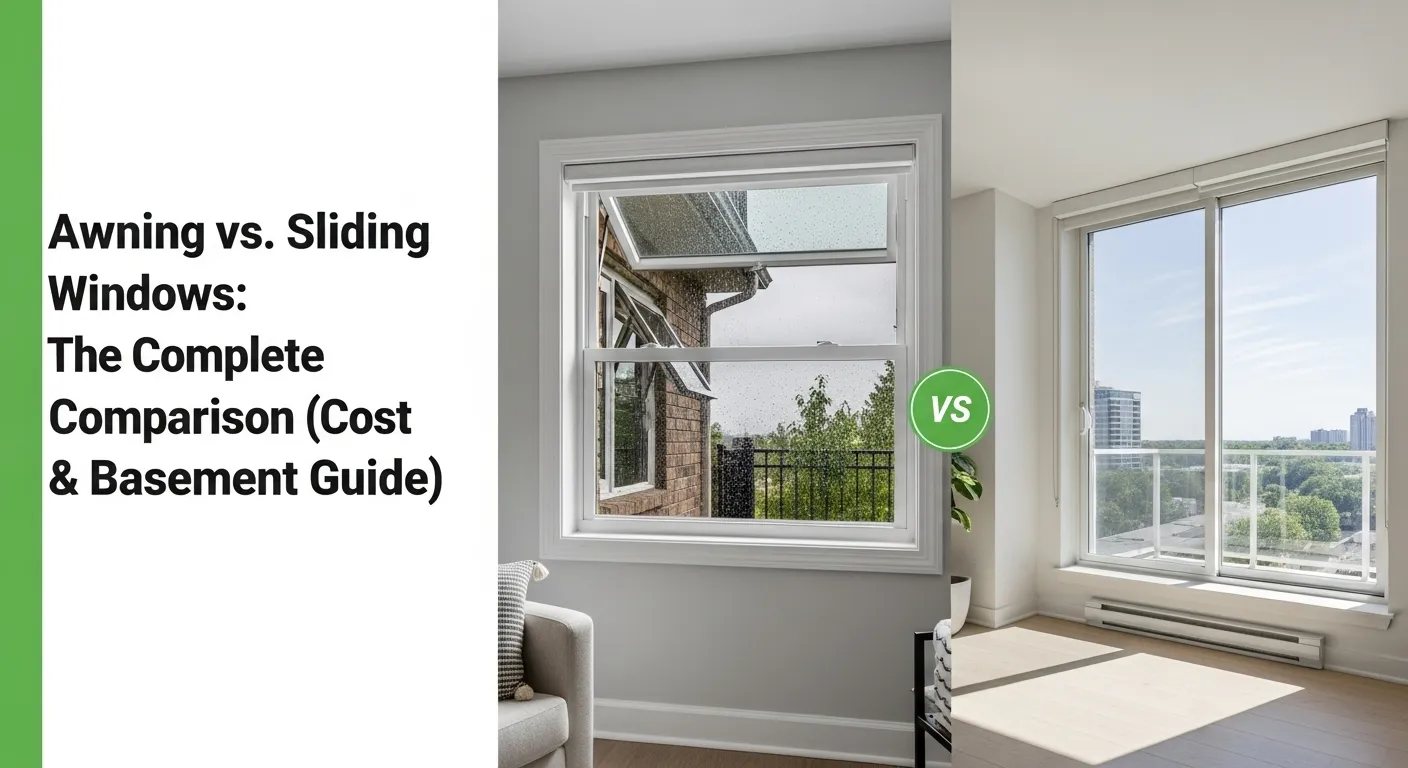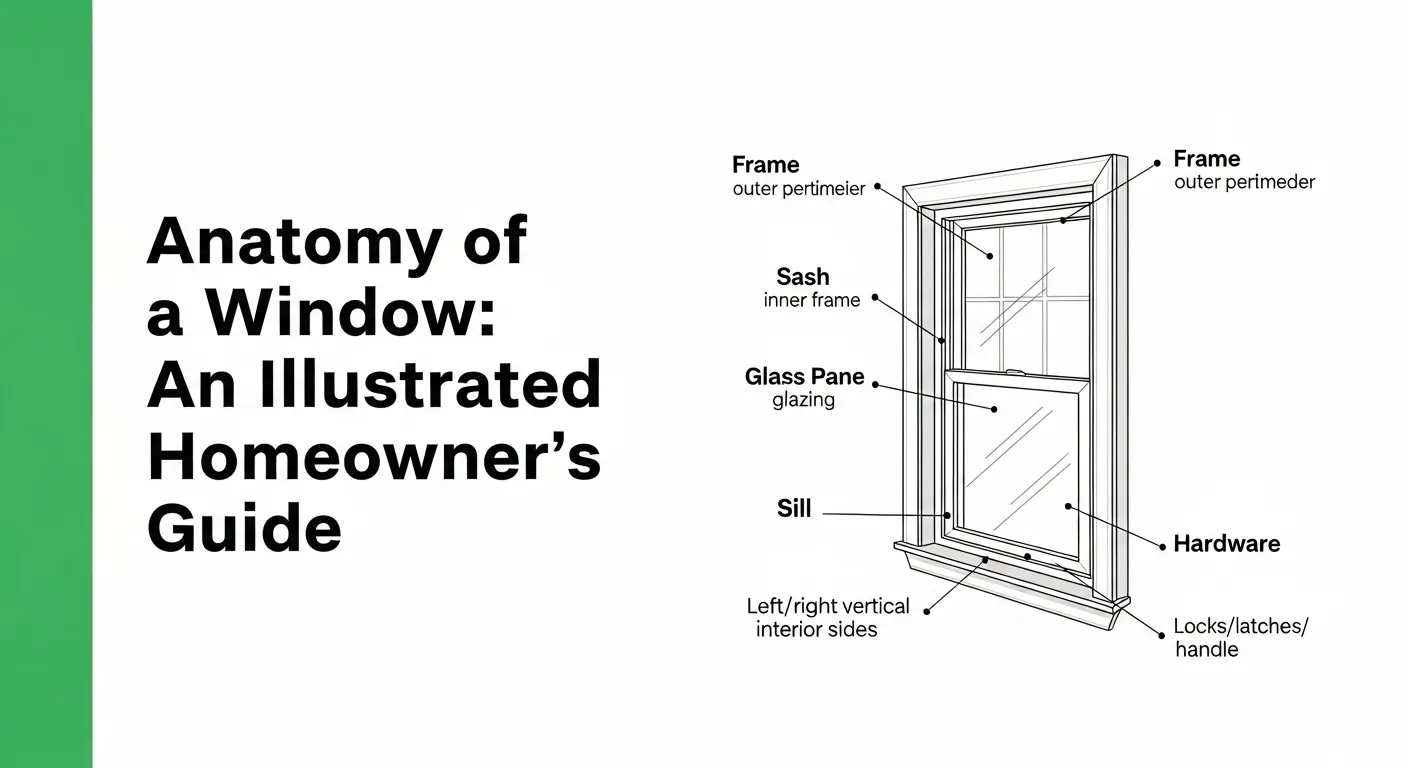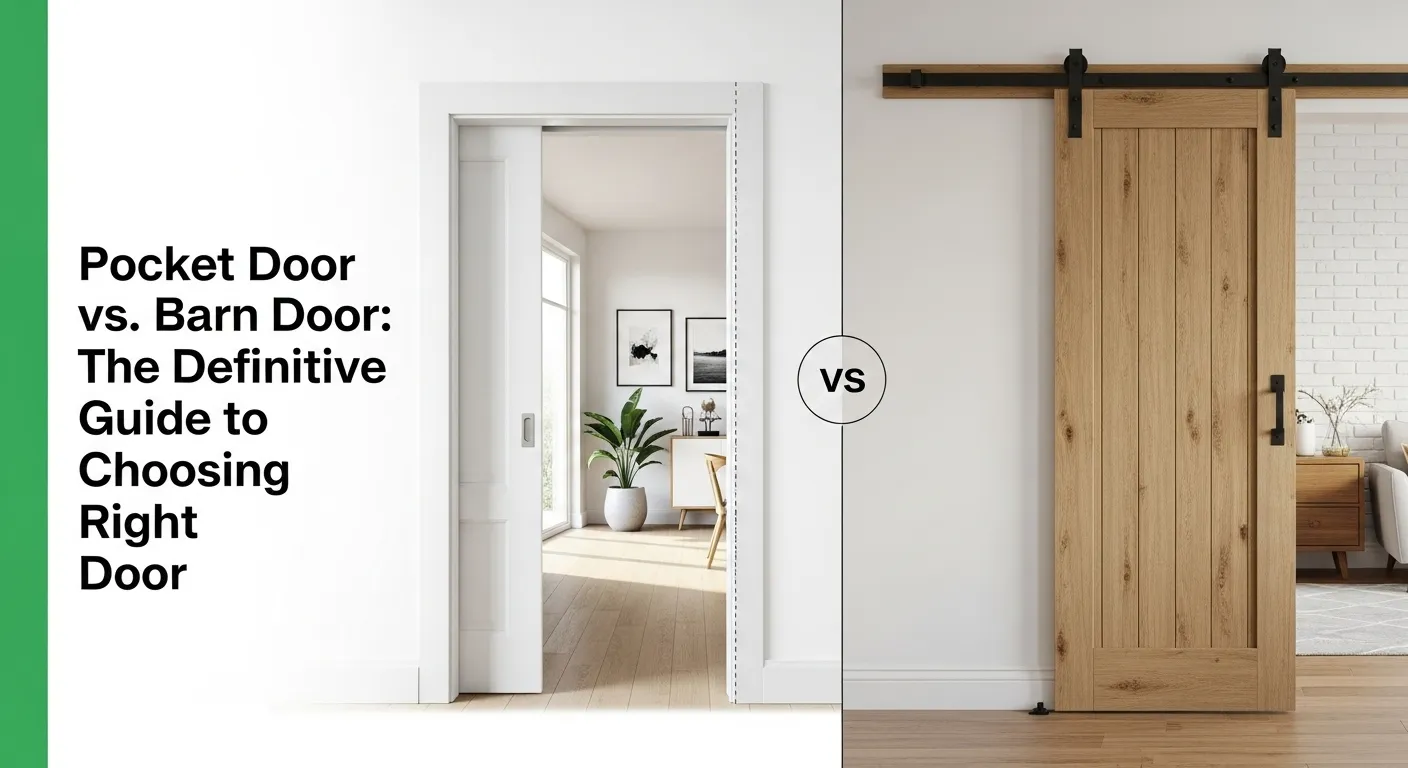A full garage door replacement costs between $1,200 and $6,000 on average in 2025, including professional installation.
Why such a wide range? The final price depends on three major factors:
- Material choice: A basic non-insulated steel single door starts around $1,000–$1,400, while premium options like a custom wood carriage house or full-view glass double door can exceed $6,000, and in some high-end cases approach or surpass $8,000 for particularly large or ornate installations.
- Size: Single-car doors (roughly 8’×7′) cost significantly less than double-car doors (roughly 16’×7′), with typical single-door projects often landing between $1,000 and $3,000 and double-door projects commonly ranging from $2,000 to $6,000 depending on material and hardware.
- Installation complexity: Standard installation runs $350–$900, but structural repairs, custom sizing, or low-headroom configurations can add $250–$2,000+ to the total cost.
This guide’s purpose: We break down every cost component—door material, size, insulation, installation labor, and opener replacement—so you can budget accurately. We’ll also help you determine if a simple repair (spring or panel) is the smarter financial choice.
Custom garage doors made just for you — stylish, secure, and built to last.
Design Yours TodayKey insight for 2025: Material costs have stabilized after the 2022–2023 supply chain volatility, but labor rates have risen due to skilled technician shortages. Expect to pay about $75–$125 per hour for professional installation in most U.S. markets.
Explore styles before you budget: Garage Door Styles & Types.
Quick Navigation
- Repair vs. Replace: Do You Need a Full Replacement?
- Cost by Material (Steel, Wood, Glass)
- Single vs. Double Door Costs
- Installation & Opener Costs
- How to Save Money
- ROI & Investment Value
Repair vs. Replace: Are You Sure You Need a Full Replacement?
Many homeowners search for “garage door replacement” when they actually need a $150–$700 repair. Before spending $1,200–$6,000 on a new door, diagnose the problem.
The most common garage door issues are repairable, not grounds for replacement. Let’s address the top three scenarios.
The “Broken Spring” Problem (A Common Repair, Not Replacement)
A broken torsion spring remains the #1 garage door repair and accounts for nearly 40% of service calls. This is not a replacement—it’s a $150–$450 repair.
What happened:
Garage door springs counterbalance the door’s weight (typically 150–300 lbs). They’re under extreme tension and generally fail after 10,000–15,000 cycles (about 7–12 years for most households).
Average spring replacement cost:
Single torsion spring: $150–$350 (parts + labor)
Double torsion spring system: $250–$450
Extension springs (older systems): $120–$250
Why professional installation is non-negotiable:
Torsion springs store 200+ ft-lbs of torque. Improper handling leads to dozens of ER visits annually (CPSC data). DIY spring replacement voids warranties and risks severe injury.
When springs indicate full replacement:
If your door is 15+ years old and the springs (and other key hardware) are worn down, replacing the entire door may make more sense due to compounding mechanical wear.
The “Damaged Panel” Problem (When to Repair vs. Replace)
Yes, you can replace a single damaged panel for $300–$900, but it’s often impractical due to color-matching issues and labor intensity.
Single panel replacement cost:
The color-matching problem:
Even if you find the exact model, UV exposure fades garage doors 1–2 shades over 5–10 years. Your new panel will likely be visibly brighter or darker than the rest of the door.
Labor complexity:
Panel replacement requires disassembling the door section by section, which takes 1–2 hours for a single panel but can extend to 3–4 hours for multiple panels. For this reason, many contractors charge 60–80% of a full door replacement for multi-panel repairs.
Replacement is smarter if:
- 2+ panels are damaged (labor cost approaches full replacement)
- The door is 10+ years old (other panels will fail soon)
- You want to upgrade insulation or style
When Full Replacement Is the Only Option
Replace, don’t repair, if your door exhibits any of these conditions:
✅ Widespread rust or rot (especially bottom panels on steel/wood doors)
✅ Severe warping or bowing (indicates structural failure)
✅ The door is 15–20+ years old and showing multiple failure points
✅ Major collision damage (car impact, fallen tree)
✅ You want to improve home value (new doors return a high ROI at resale)
✅ Energy efficiency upgrade (old non-insulated door on an attached garage)
Cost-benefit analysis:
If repair costs exceed 50% of replacement cost, replacement is the better investment. For example:
- Spring + 2 panels + hardware = $800–$1,200 → Just $300–$800 more for a brand-new insulated door.
Garage Door Cost Breakdown by Material
Material is the primary cost driver. Steel dominates 60% of the market due to durability and affordability, while wood and glass serve premium aesthetic markets.
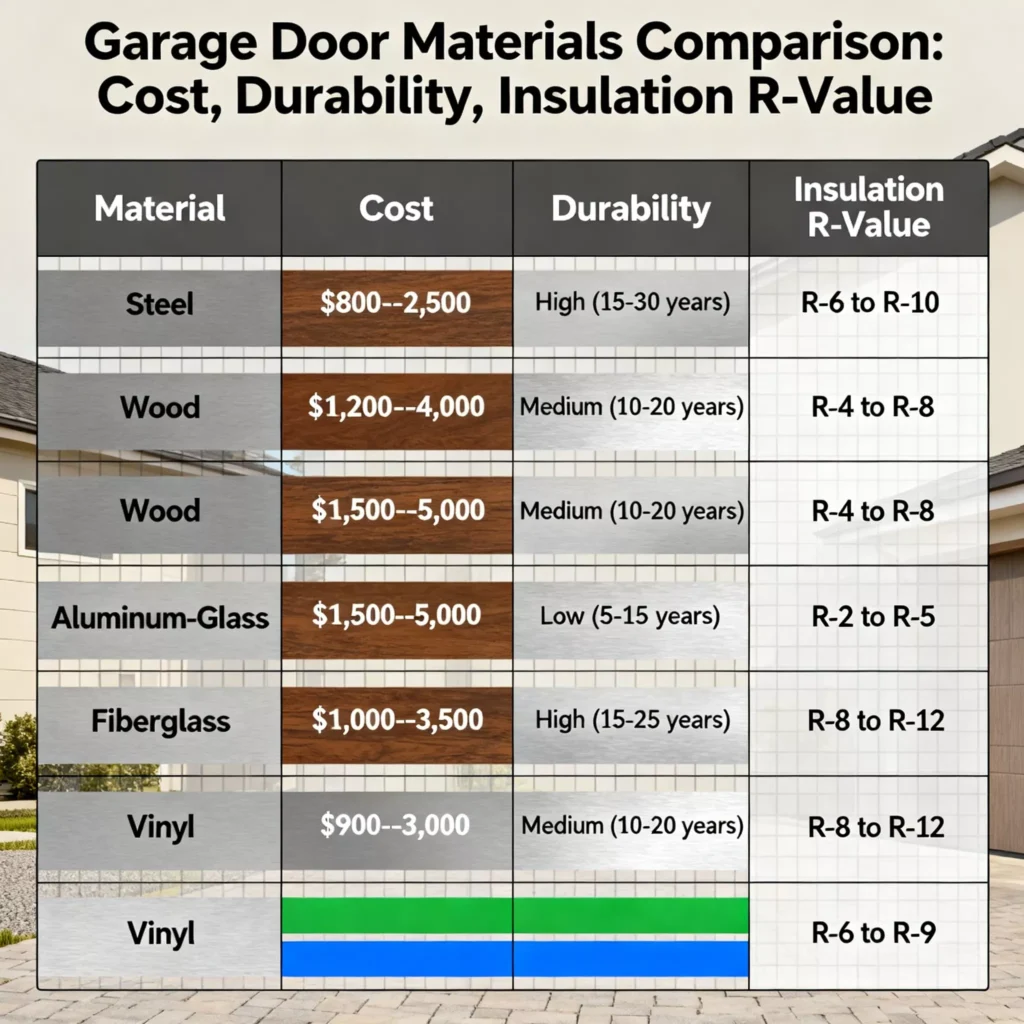
Steel Garage Doors (Most Popular): $750–$3,500
Steel is the best value for most homeowners—durable, low-maintenance, and available in every style from traditional raised-panel to modern flush designs.
Cost range by construction:
- Single-layer (non-insulated): $750–$1,200 (single door), $1,200–$1,800 (double door)
- Double-layer (insulated with polystyrene): $1,000–$2,000 (single), $1,800–$3,000 (double)
- Triple-layer (insulated with polyurethane, R-16 to R-18): $1,500–$2,500 (single), $2,500–$4,000 (double)
Advantages:
- Durability: 20–30 year lifespan with minimal maintenance
- Insulation options: R-values up to 18.4 (critical for attached garages)
- Style variety: Can mimic wood grain or carriage house designs
- Rust resistance: Galvanized and powder-coated finishes prevent corrosion
Disadvantages:
- Denting: Susceptible to hail, basketballs, and car bumps (24-gauge dents more easily than 25-gauge)
- Rust (in coastal/humid climates): Bottom sections exposed to salt or moisture require periodic touch-up
Best for:
- Budget-conscious homeowners, attached garages needing insulation, high-wind zones
Compare steel options: Aluminum vs. Steel Garage Doors.
Wood & Wood Composite Garage Doors: $1,200–$10,000+
Wood offers unmatched natural beauty but requires significant maintenance and comes at a premium price.
Cost range:
- Overlay (steel with wood veneer): $1,200–$2,500 (single), $2,000–$4,000 (double)
- Composite (wood fibers + resin): $1,500–$3,500 (single), $2,500–$5,500 (double)
- Solid wood (cedar, redwood, mahogany): $2,500–$6,500 (single), $4,000–$10,000+ (double)
- Custom carriage house (solid wood): $6,000–$15,000+ (double with hardware)
Advantages:
- Aesthetics: Rich, authentic grain patterns; ideal for historic or luxury homes
- Customization: Can be stained, painted, or carved to match architectural details
- Curb appeal: Highest resale value impact, with some wood doors returning up to 100%+ ROI in upscale markets
Disadvantages:
- Maintenance: Requires re-staining or sealing every 2–4 years to prevent warping, cracking, and rot
- Weight: Requires heavy-duty springs and openers (adds $200–$500 to installation cost)
- Cost: 2–4× more expensive than typical steel doors
- Insulation: Poor R-value unless sandwiched with foam or composite core (rare in solid-wood types)
Best for: Historic homes, high-end curb appeal projects, or detached garages where insulation is less critical.
Aluminum & Glass Garage Doors (Modern Style): $2,500–$12,000+
Aluminum-framed glass doors are the signature of contemporary architecture—full-view designs flood garages with natural light and create seamless indoor-outdoor transitions.
Cost range:
- Aluminum frame with clear glass: $2,500–$4,500 (single), $4,500–$7,000 (double)
- Aluminum frame with frosted/tinted glass: $3,000–$5,500 (single), $5,000–$8,000 (double)
- Commercial-grade (full-view, 12’×12′ or larger): $6,000–$12,000+
Advantages:
- Natural light: Transforms dark garages into usable living or workshop spaces
- Modern aesthetic: Sleek, minimalist design ideal for mid-century modern or industrial-style homes
- Low maintenance: Aluminum doesn’t rust; tempered and laminated glass resist breakage and weathering
Disadvantages:
- Insulation: Very low R-value (R-1 to R-4) unless specified with insulated or laminated glass, which adds $800–$1,500
- Privacy: Clear glass exposes garage contents, though frosted or tinted glass options improve discretion
- Cost: Typically 2–3× higher than insulated steel for comparable sizes
- Cleaning: Requires frequent maintenance to keep glass panels free of streaks and fingerprints
Best for: Modern or contemporary homes, detached garages, home gyms, and show-quality car storage spaces.
Explore modern designs: Garage Door Styles & Types.
Fiberglass & Vinyl Garage Doors: $1,000–$4,000
Fiberglass and vinyl are low-maintenance alternatives to wood, mimicking wood grain without the upkeep, but they’re less durable.
Cost range:
- Fiberglass: $1,000–$2,500 (single), $1,800–$4,000 (double)
- Vinyl: $1,200–$2,800 (single), $2,000–$4,500 (double)
Advantages:
- Maintenance-free: Never needs painting or staining
- Rust/rot-proof: Ideal for coastal, humid, or extreme climates
- Lightweight: Requires less powerful openers and lighter hardware
Disadvantages:
- Brittleness in cold climates: Fiberglass can crack below freezing; vinyl may become brittle in extreme cold
- Fading: UV exposure can cause discoloration or yellowing over 10–15 years
- Impact resistance: Cracks or splits from hail, debris, or impacts
- Limited styles: Fewer design options than steel or wood
Best for:
- Coastal homes, humid climates, and low-traffic detached garages where low maintenance is a priority
Material Comparison Table
| Material | Cost Range (Installed) | Lifespan | Insulation (R-Value) | Maintenance | Best For |
|---|---|---|---|---|---|
| Steel | $750–$3,500 | 20–30 years | R-0 to R-18 | Low (occasional rust touch-up) | Most homes, attached garages |
| Wood | $1,200–$10,000+ | 15–25 years | R-0 to R-10 | High (re-stain every 2–4 years) | Luxury homes, curb appeal |
| Aluminum/Glass | $2,000–$8,000+ | 20–30 years | R-1 to R-4 | Low (glass cleaning) | Modern homes, natural light |
| Fiberglass | $1,000–$4,000 | 10–20 years | R-4 to R-10 | Very low | Coastal/humid climates |
| Vinyl | $1,200–$4,500 | 15–25 years | R-4 to R-12 | Very low | Extreme climates, detached garages |
Cost Breakdown by Size (Single vs. Double Garage Doors)
Door size directly impacts cost—double doors cost 50–80% more than single doors due to larger panels, heavier-duty hardware, and increased labor.
Single-Car Garage Door (8’×7′ or 9’×7′): $750–$2,500
Single-car garage doors are the most affordable option, ideal for one-car garages, workshops, or side-entry garages.
Standard dimensions:
- 8 feet wide × 7 feet tall (most common)
- 9 feet wide × 7 feet tall (wider vehicles, SUVs)
Cost range by material (installed):
- Steel (non-insulated): $750–$1,200
- Steel (insulated, R-12 to R-16): $1,000–$1,800
- Wood composite: $1,500–$2,500
- Aluminum/glass: $2,000–$3,500
Installation labor: $250–$500 (2–3 hours)
When to choose single doors:
✅ One-car garages
✅ Side or rear garage entries
✅ Detached workshops or sheds
✅ Budget-conscious projects
See standard sizing: Garage Door Size Guide.
Double-Car Garage Door (16’×7′ or 18’×7′): $1,500–$6,000
Double-car garage doors are the standard for modern homes—accommodating two vehicles side-by-side or one truck/SUV with room to spare.
Standard dimensions:
- 16 feet wide × 7 feet tall (standard two-car)
- 18 feet wide × 7 feet tall (wide two-car, trucks, SUVs)
Cost range by material (installed):
- Steel (non-insulated): $1,200–$2,000
- Steel (insulated, R-12 to R-18): $1,800–$3,500
- Wood composite: $2,500–$5,000
- Solid wood or carriage house: $4,000–$10,000+
- Aluminum/glass (full-view): $3,500–$8,000+
Installation labor: $400–$700 (4–6 hours)
Key cost drivers for double doors:
- Larger panels: Require more material and heavier-gauge steel (24 vs. 25)
- Heavy-duty hardware: Tracks, rollers, and springs must support 250–400 lbs
- Opener requirements: Requires ½ HP or ¾ HP opener (vs. ⅓ HP for single doors)
Two single doors vs. one double door:
Some garages use two single 8’×7′ or 9’×7′ doors instead of one 16’×18′ double. This configuration:
- Costs 10–15% more (double the hardware and labor)
- Offers redundancy (if one door fails, you can still access the garage)
- Provides design flexibility (different styles or colors)
Best for: Standard 2-car garages, attached garages needing insulation, and homes prioritizing curb appeal.
Deconstructing Installation & Labor Costs
Professional installation adds $350–$700 to your project, but it’s non-negotiable for safety, warranty protection, and proper door balance.
What’s Included in Standard Installation? ($350–$700)
Installation labor accounts for 25–35% of total project cost and includes critical safety and precision work.
Typical labor breakdown (3–6 hours):
- Removal and disposal of old door: $50–$150 (haul-away fees)
- Inspection and prep of opening: Checking frame squareness, repairing rotted wood
- Track and hardware installation: Vertical tracks, horizontal tracks, rollers, hinges
- Spring installation and tensioning: Torsion springs balanced to door weight (critical safety step)
- Panel assembly and alignment: Ensuring weather seals and panel gaps are uniform
- Opener connection: Programming existing opener to new door’s weight and balance
Labor rates by region (2025):
- National average: $75–$125 per hour
- High-cost metros (CA, NY, DC): $100–$150 per hour
- Low-cost regions (Midwest, South): $60–$90 per hour
What’s NOT included in standard installation:
- Structural repairs (framing, rotted wood): $250–$1,000
- Resizing the opening: $500–$2,000 (requires carpentry, permits)
- New opener installation: $300–$800 (see next section)
- Smart home integration: $100–$300 (Wi-Fi module, app setup)
Warning: Why DIY Garage Door Installation Is Dangerous
DIY garage door installation saves $350–$700 but risks severe injury, property damage, and voided warranties.
The life-threatening danger:
Torsion springs store 200–400 ft-lbs of torque—equivalent to the force of a car traveling 30 mph. Improper release causes:
- 50+ ER visits annually for lacerations, broken bones, and crush injuries (CPSC)
- 5–10 fatalities per year from DIY spring accidents (DASMA data)
The financial danger:
- Voided warranties: Most manufacturers void warranties if installed by non-certified technicians
- Improper balance: Causes premature opener failure ($400–$800 to replace), worn rollers ($150–$300), and bent tracks ($200–$500)
- Code violations: Many jurisdictions require licensed contractors for garage door work; DIY installations can fail inspection or affect home insurance
Frame the $350–$700 labor cost as:
A safety insurance policy, warranty protection, and guaranteed professional results. The average DIY mistake costs $500–$1,500 to fix—more than the labor savings.
Add-On: New Garage Door Opener Cost ($300–$800)
A new opener is not included in standard “door replacement” quotes unless explicitly bundled. Budget separately.
Average garage door opener costs (installed):
| Opener Type | Cost (Installed) | Noise Level | Best For |
|---|---|---|---|
| Chain Drive | $300–$500 | Loud (60–70 dB) | Detached garages, budget projects |
| Belt Drive | $400–$800 | Quiet (40–50 dB) | Attached garages, bedrooms above garage |
| Screw Drive | $350–$600 | Moderate (50–60 dB) | Mild climates, low maintenance |
| Direct Drive (Wall-Mount) | $500–$900 | Very quiet (35–45 dB) | Low-headroom garages, modern designs |
Smart/Wi-Fi add-ons: $50–$150
Features: Smartphone control, real-time alerts, voice assistant integration (Alexa, Google Home), and battery backup.
Horsepower requirements:
- Single door (8’×7′): ⅓ HP to ½ HP
- Double door (16’×7′): ½ HP to ¾ HP
- Heavy wood or oversized doors: ¾ HP to 1 HP
When to replace your opener:
- It’s 10–15+ years old (modern openers offer better safety sensors and Wi-Fi)
- It struggles to lift the new door (underpowered)
- You want smart home integration for security and convenience
Find trusted suppliers: Best Garage Door Supplier.
Other Cost Factors & Style Upgrades
Beyond material and size, insulation, style upgrades, and structural add-ons can increase your project cost by $200–$2,000+.
Insulation (R-Value): The Best “Hidden” Upgrade
Insulation is the #1 overlooked upgrade—adding R-value costs $200–$800 but delivers energy savings, noise reduction, and door rigidity.
What is R-value?
R-Value measures thermal resistance. Higher R-Value = better insulation.
Garage door insulation tiers:
- Non-insulated (single-layer steel): R-0 (no insulation)
- Polystyrene insulation (double-layer): R-4 to R-8 ($200–$400 upgrade)
- Polyurethane insulation (triple-layer): R-12 to R-18.4 ($400–$800 upgrade)
Cost-benefit analysis:
- Attached garage: Insulated doors reduce heating/cooling costs by 10–20% (up to $200/year in cold climates)
- Noise reduction: R-12+ doors reduce street noise by 20–30 dB
- Durability: Insulated doors are stiffer, resist denting, and last 5–10 years longer
When insulation is non-negotiable:
✅ Garage shares a wall with living space
✅ Bedroom or home office is above the garage
✅ You work in the garage (workshop, gym, hobby space)
✅ Climate has temperature extremes (below 20°F or above 90°F)
See insulation principles: What are window R-values?
Style Upgrades: Carriage House, Windows, and Hardware
Aesthetic upgrades add $250–$2,000+ but significantly boost curb appeal and home value.
Carriage house style: $200–$1,000 premium
Mimics historic swing-out carriage doors with decorative hardware, arched windows, and crossbuck or plank designs. Popular for craftsman, colonial, and traditional homes.
Window options:
- No windows (solid door): Base price
- Single row of windows (4–8 panels): $250–$600
- Two rows or full-window top section: $500–$1,200
- Custom shapes (arched, sunburst): $800–$2,000+
Glass types:
- Clear glass: Base price (shows garage interior)
- Frosted/obscured glass: +$100–$300 (privacy)
- Tinted glass: +$150–$400 (glare reduction, privacy)
- Insulated glass (double-pane): +$300–$800 (energy efficiency)
Decorative hardware (handles, hinges, straps):
- Basic hardware: Included
- Decorative hardware kit: $50–$200 (faux iron, bronze, black)
- Custom forged hardware: $300–$1,000+ (hand-crafted, luxury homes)
Other Potential Charges in Your Quote
These “hidden” costs appear when your garage opening needs structural work or special configurations.
Resizing or reframing the opening: $250–$1,000
Required if:
- Old frame is rotted or damaged
- You’re upgrading from a single to double door (or vice versa)
- Opening isn’t square or plumb
Low-headroom kit: $100–$300
For garages with less than 12 inches of headroom between the door opening and ceiling. Requires special track hardware.
High-lift or vertical-lift tracks: $300–$800
For garages needing extra ceiling clearance (car lifts, storage platforms).
Permit and inspection fees: $50–$200
Some jurisdictions require permits for garage door replacement.
Haul-away and disposal: $50–$150
Removal of old door, tracks, and springs (included in most quotes, but confirm).
How to Save Money on Your Garage Door Replacement
Follow these six strategies to save $300–$1,500 without sacrificing quality or safety.
1. Get 3+ Quotes (The #1 Rule)
Price variation between contractors can be 20–40% for the same door and installation.
How to get accurate quotes:
- Request itemized quotes (door, labor, hardware, disposal separately)
- Compare same models and R-values (not just “insulated steel door”)
- Verify warranty terms (manufacturer + installation warranty)
- Check licensing and insurance (avoid unlicensed installers)
Red flags:
- Quotes significantly below market rate (low-quality materials, unlicensed)
- Pressure to sign same-day (reputable contractors don’t use high-pressure sales)
- No written warranty (verbal promises are unenforceable)
2. Choose Standard Steel (The Sweet Spot)
A double-layer insulated steel door offers the best blend of cost, durability, and energy efficiency for most homes.
Recommended configuration:
- Material: 24- or 25-gauge steel
- Insulation: R-12 to R-16 (polyurethane)
- Style: Raised panel or carriage house overlay
- Windows: 1 row (4–8 panels, frosted glass)
Cost: $1,800–$3,000 (double door, installed)
Why this is the “Goldilocks” choice:
- Durability: 20–30 year lifespan
- Energy efficiency: Cuts heating/cooling costs 10–15%
- Aesthetics: Wide variety of colors and styles
- Maintenance: Minimal (wash annually, lubricate hardware)
3. Reuse Your Existing Opener (If It Works)
If your current opener is less than 10 years old and functions properly, keep it—it saves $300–$800.
When it’s safe to reuse:
- Opener is ½ HP or higher (sufficient for most doors)
- Has modern safety sensors (photoelectric eyes, auto-reverse)
- No grinding, jerking, or slow operation
- Remote and controls work reliably
When replacement is necessary:
- Opener is 15+ years old (lacks modern safety features)
- New door is significantly heavier (wood, insulated triple-layer)
- You want smart home integration (Wi-Fi, app control)
4. Schedule in the Off-Season (October–January)
Demand for garage door installation spikes in spring (March–May) and late summer (July–September). Booking in the off-season can save 10–20% through discounts and faster scheduling.
Search trend data (2024–2025):
- Peak demand: March (spring home improvement), July–August (pre-school/move-in season)
- Low demand: October–January (holiday season, cold weather)
Off-season advantages:
- Negotiating power: Contractors are less busy, more willing to discount
- Faster installation: No 3–6 week wait times
- Better availability: Access to premium models and custom orders
Pro tip: Get quotes in September, schedule installation for October–November (after summer heat, before holiday freeze).
5. Skip Unnecessary Upgrades
These upgrades add cost but minimal functional value for most homes.
Skip or downgrade:
- Triple-layer insulation (R-16+): Overkill for detached garages or mild climates (save $300–$600)
- Decorative hardware: Unless critical for curb appeal (save $50–$300)
- Custom colors: Stock colors (white, almond, sandstone) avoid 2–4 week lead times and $200–$500 premiums
- Second row of windows: Adds cost and reduces insulation (save $300–$600)
6. Check for Energy Rebates
Some utility companies and local governments offer $100–$500 rebates for installing insulated garage doors (R-12+).
How to find rebates:
- Check DSIRE database (Database of State Incentives for Renewables & Efficiency)
- Contact your local utility company (electric/gas provider)
Requirements:
- Minimum R-value (usually R-12 or R-16)
- Installation by licensed contractor
- Proof of purchase and installation certificate
The ROI of a New Garage Door (Why It’s a Smart Investment)
A new garage door is one of the highest-ROI home improvements, returning 94–102% of its cost at resale (Remodeling Magazine’s Cost vs. Value Report 2024).
Average ROI by project tier:
- Mid-range door replacement (steel, insulated): 102% ROI ($2,000 cost, $2,040 added value)
- Upscale door replacement (carriage house, wood-look): 94% ROI ($5,000 cost, $4,700 added value)
Why garage doors deliver such high ROI:
- Curb appeal dominance: The garage door covers 30–40% of a home’s front facade—more visible than any other single feature
- First impression: The #1 feature buyers notice from the street
- Buyer perception: Signals a “well-maintained home” and “move-in ready” status
- Energy efficiency: Insulated doors reduce heating/cooling costs (appealing in competitive markets)
- Security upgrade: Modern doors with smart openers enhance safety (theft deterrent)
Beyond resale value—quality of life benefits:
- Lower energy bills: $100–$300/year in heating/cooling savings (attached garage)
- Noise reduction: 20–30 dB quieter operation and street noise blocking
- Increased usable space: Insulated garages are comfortable workshops, gyms, or hobby spaces
- Enhanced security: Modern openers with rolling codes prevent break-ins
Strategic timing for maximum ROI:
Replace your garage door 1–2 years before selling. This allows you to enjoy the benefits while ensuring the door looks fresh and new during listing photos and showings.
Conclusion: Your Final Budget & Next Steps
Use these cost guidelines to build your 2025 garage door replacement budget:
For a repair (spring, panel, hardware):
Budget $200–$800 → Often the smarter financial choice for doors <10 years old with isolated damage.
For a full single-door replacement:
Budget $750–$2,500 → Best for detached garages, side entries, or budget-conscious projects.
For a full double-door replacement (most common):
Budget $1,500–$4,500 → Sweet spot is $2,000–$3,500 for a quality insulated steel door with professional installation.
For premium or custom doors:
Budget $5,000–$10,000+ → Wood carriage house, full-view glass, or custom designs for luxury homes.
Ready to Upgrade? Order Your Custom Garage Door Today
Transform your home’s curb appeal, energy efficiency, and security with a new garage door from us.
✅ Custom sizing and configurations
✅ Steel, wood, aluminum, and glass options
✅ R-12 to R-18 insulation packages
✅ Professional installation with lifetime warranty
✅ Smart opener integration
Order a Custom Garage Door from Us
